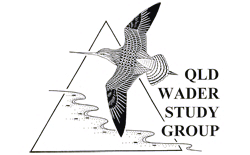Rostratula benghalensis
Subspecies
R. b. benghalensis
R. b. australis (the Australian race)
Other Names
Australian painted Snipe, Greater Painted Snipe
Identification
Very distinctive wader of freshwater wetlands. Sexual dimorphism i.e. the male and female are different, and in this species the female is brightest.
Plumage
Male Plumage: The crown and nape are mottled grey with a central white stripe. The feathers around the eye and the supercilium are buff, with the rest of head and neck are also mottled grey. The mantle and scapulars are blue-grey and mottled with white. The edge of the mantle has a buff “V”. The wing coverts are grey green with big buff spots that are edged with grey. The chin, throat and upper breast are mottled grey. Around the lower neck is a white line that is bordered by black. The lower breast, belly, flanks and vent are white. The bill is long and pale pinkish brown. The legs are pale olive-grey.
Female Plumage: The head, neck, the mantle, throat and upper breast are a rich maroon. The crown of the head has a central white stripe. The feathers around the eye and the supercilium are also white. The shoulders are greenish-brown mottled with black and white. The wing coverts are a glossy green and barred with black. The sides of the breast are black almost forming a breast bar. The rest of the underparts are white. The bill is long and pale pinkish brown. The legs are pale olive-grey.
Juvenile: Similar to the male plumage but the wing coverts are duller and tipped buff.
Distribution
Spread over a vast area of eastern Australia from the Eyre peninsula in South Australia through Victoria, New South Wales and Queensland to the Mount Isa region. It is commoner Victoria and New South Wales. It likes shallow wetland areas.
Migratory habits
This species moves seasonally, but is not an international migrant. It seems to move with the rains and move from the southernmost areas in the winter months.
Breeding
Breeds between August and February nesting in wetlands using a platform of plant material to lay its 2-4 eggs. This species is polyandrous ie. the female has many male partners leaving them to do the incubation for 24 days and tending the young.
Status
Rare. Estimated population for Australia is about 1,500 birds. Its cryptic plumage and habits make this a hard bird to find.
Confusing Species
None; though Latham’s Snipe might be confused when flushed.
